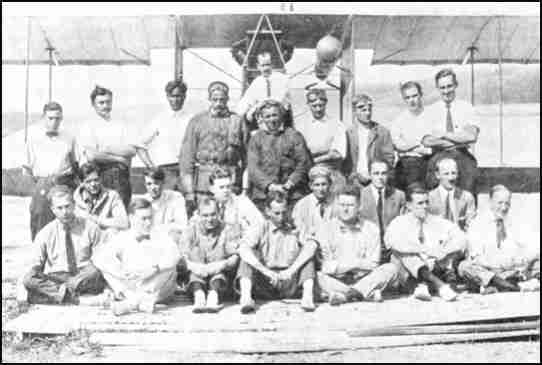
1888-1916 |
 |
Curtiss Class of 1913 Curtiss Museum Photo |
|
in the Philippines. by Avelino L. Zapanta, 9-30-06 Niles had impressive credentials for the job at hand. He was in the Class 1913 of Glenn Curtiss which included some other famous U.S. flyers like Jack McCurdy, Charles Witmer and Ray Morris. Like most early aviators, right off their short flight instruction, they quickly show their proficiency and Niles was one of them. Within the year of graduation he was performing death-defying aerobatics in the U.S. and in Central America. Before coming to the Philippines in 1916 he had already performed in Shanghai, Peking, Hong Kong and Tokyo since November 1915. Niles brought with him two airplanes consisting of a Huntington Monoplane especially built for him by the Huntington Aircraft Company designed for stressed exhibition work. The second airplane was a Christofferson Biplane. His managers, the Friedman brothers Leon and Max were joined by Tom Gunn's former manager Newman in setting Niles up at the Manila Polo Club near Pasay Beach, which was chosen as the site for the exhibition. Niles lived up to expectations. He performed the French loop made famous by Frenchman Adolphe Pegoud in 1913, upside down flying, and other nerve-wracking stunts. He scared the spectators with free falling with engine off and on just in time. He hurtled down to earth at great speed only to level off just in time and land light as a feather. He was a total sensation. He was known for being a crowd pleaser and would take unnecessary risks just to satisfy the crowd. In his last performance in Manila, despite protests from his mechanics and handlers, he flew, dived and performed aerobatics despite knowing there was trouble with his engine, which fortunately gave up only after he had landed that last flight. For all his bravura he won an American girl residing in Manila as wife and left with her in May 1916 to become the last male American barnstormer to perform in the country. In an exhibition flight in Oshkosh, Wisconsin on June 25, 1916, Niles crash-landed and died. The short-lived dangerous career of thrill of three years explains the scant information about Niles in the U.S. aviation accounts, but his faithfully recorded performance in the Philippines and Asia is a testimony to this gutsy flyer that lived to please others. |
 |
| Class of 1913, June-July, Glenn H. Curtiss in front of engine. Back row, standing; 1. Charles F. Niles; 2. Frank Thalman; 3. Mohan Singh; 4. J.L. "Lanny" Callan, instructor; 5. Francis "Doc" Wildman ; 6. John Van Vleet, instructor; 7. Frank Auckerman; 8. Leon Englehardt; 9. Steve MacGordon. Seated, middle row: 1. L. Sperry; 2. Z.T. Barns; 3. M. Bates; 4. Leon "Windy" Smith; 5. Fred S. Gostenhofer; 6. H. Figelmessy; Front row, seated: Charles C. Witmer, Ray Morris, J.A.D. "Jack" McCurdy, naval constructor, H.C. Richardson, Lt. Bellinger, John D. Cooper |
|
American Aviation Historical Journal. |
|
Daily Journal and Tribune, Knoxville, Tennessee: October 17, 1913, Transcribed by Bob Davis - 9-14-03 Bob Davis |
|
from the Early Birds of Aviation CHIRP June, 1937 - Number 20 |
|
courtesy of Steve Remington - CollectAir |
|
Knoxville Journal and Tribune, Knoxville, Tennessee: February 3, 1914, Transcribed by Bob Davis - 2-11-07 |
|
|
|
|
|
|
|
|
|
|
|
If you have any more information on this Early Flier please contact me. E-mail to Ralph Cooper Back 

|